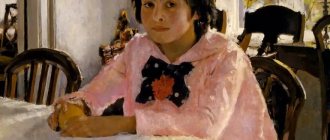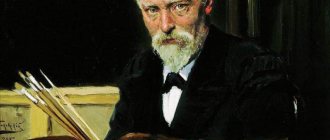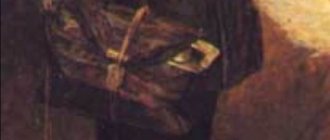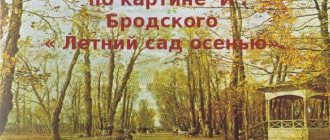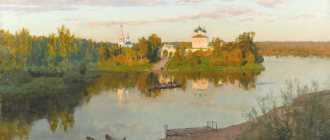Description of the painting “Flood” by Soviet artist Alexei Komarov, essay for 5th grade school.
Author of the painting Flood:
The author of this work is Alexey Nikanorovich Komarov (1879-1977). A. N. Komarov became known as a sculptor and animal painter, an illustrator of magazines and books, in particular, books by naturalist writers.
Description of the painting by Komarov Flood
The plot of the film “Flood” takes place in the spring. Due to the fact that the flood began, the hare found itself in a difficult situation. The melted snow and overflowing river flooded the entire area, and the hare fell into a real trap. He managed to climb onto a tree branch to escape the water, but now he literally has nowhere to go. The water continues to rise, and the frightened hare sits on a branch. Now he is more collected than ever, as he finds himself in a very delicate situation. He carefully watches everything that happens around him, since he is in an open area. His ears are raised up and listen to every noise, every rustle.
The hare himself has already begun to change his fur. He is still white after winter, but gray fur begins to appear on his back, giving him a variegated color.
In the painting, Komarov depicted early spring. The trees are still bare, but the coming warmth melted the snow, which is why the flood happened. If earlier there was a clearing here where hares could find food or hide, now a whole lake overflows here. The hare never expected that the water would surround him on all sides, and he would have no choice but to climb onto a branch and try to wait for the water to finally go away and open his way home.
The hare is scared, but there is no need to worry about him. Hares know how to swim and do it very well; they can quite calmly swim across a river. However, the fact is that hares really do not like water, and will endure until the last moment not to enter it. In simple words, hares swim only in cases of extreme necessity, when there is no other way out. In early spring, when the water has just melted and is still very cold, you cannot drive the hare into the water at all, so if there is an opportunity to sit out the flood, it will remain on the branch until the last. If the water rises even more and floods the branch, the bunny will still be forced to give up his fears of water and swim to the nearest shore of land.
Alexey Komarov specially completed the painting in gray tones. It’s early autumn outside, the dirty gray sky is reflected in the water and makes the whole area even grayer, bare trees, bare ground exposed from under the recently lying snow. After a snow-white winter, early spring, right up to the moment when the buds begin to bloom and the grass begins to emerge, always looks quite dull.
Mosquitoes Flood essay plan 5th grade
- Author of the picture
- Season and nature
- The plot of the picture
- How did the hare end up in the tree?
- How does a hare behave?
- What should a hare do?
- My impressions
Essay based on the painting by A. N. Komarov “Flood” for 5th grade
Drawings on the theme of spring are often associated with flooding, such is their specificity. The picture that we will describe is no exception.
The canvas shows that winter has already ended, but spring has not yet “come into its own.” The trees are bare, there are no leaves on them, and there are also no swollen buds. Judging by the landscape, it is difficult to determine the exact time of year; most likely the events take place in March.
Tree trunks are buried in water that reaches the very branches. To paint meltwater, the artist chose gray color. In this way, showing that the water is still cold and dirty.
In the distance you can see thawed patches on which there is still unmelted snow.
The gray, spring weather is conveyed very well, the branches barely touch the muddy water or hang over it.
This painting is considered one of the artist’s most successful. It is no secret that Komarov loved to paint animals; he drew some from life. The key character in this picture is the hare, which has not yet changed its fur.
A frightened animal sits on a tree branch that hangs over the melt water. The hare's ears are pressed to his head, visually he is very frightened.
The fear that he experiences in front of the unknown is clearly visible in the eyes of the animal. After all, due to the large amount of water, he does not know where to run. Essentially, the hare is trapped. If the water rises any further, he will die, drown. This scares the animal.
The hare is trying to find a safer place for himself and at the same time is afraid of predators that could harm him.
Description of the painting Warning
Each work of the famous talented artist Alexei Nikanorovich Komarov depicting animals sinks into the viewer’s soul, evoking the kindest feelings.
Admiring the painting called “Flood,” we become so close to nature that we feel like we are participating in an event taking place in early spring. It depicts one of the representatives of the animal world, which is actually harmless compared to many others. As fate would have it, the hare ended up on a tree branch due to the fact that he was caught by the elements - a flood. Apparently, the tree trunk has been in the water for a long time. The hero sits, ruffled from cold and fear, since the water is not going to subside. The surface seems to be covered with feathers. On one side, the water surface appears to be a cold gray-blue color. On the other, a dark, ominous hue glows from inside, frightening the animal even more. During the time when he jumped in and sat on the branch, the hare was frozen, as the water was very cool. There is not a single leaf on the tree, which indicates recently melted snow. Therefore, nature has not yet awakened, and the earth has not warmed up after a long winter.
Watching the eyes of a bunny in trouble, you can say that he is confused from hopelessness. He looks sadly and fearfully at the water with wide eyes, hoping for help. Over time, he seemed to back away and ran into a strong tree trunk, flooded with water. There is no way for him further. So the unfortunate man froze in anticipation of a miracle.
The animal's muzzle is warily directed forward. He cannot relax or doze off, because in one second he can find himself in the water. The fact that he is too scared is indicated by long ears sticking up and pursed paws. The hero's fur is thick, standing on end, it shows how scared the hare is. Its upper part is darker, the belly is lighter. Looking at him, one feels a shiver from the cold. But he is constantly attentive and focused. The only thing that gives him hope and saves him at the moment is a thick tree branch that does not even bend under the weight of the hare.
In the background you can see a strip of forest located very far away. This suggests that the animal cannot reach the shore on its own. The piece of sky depicted by the artist is not like the spring skies from which the sun's rays come. It feels freezing cold here.
The painting is made using several colors, but it is attractive and reminiscent of reality. Without a doubt, you can recognize both the animal and the time of year.
What the artist depicted in the painting “Flood” cannot leave a single person indifferent. An animal in danger, between life and death, evokes compassion. Looking around at the flooded forest, at the expanse of water that surrounds the animal, we understand that a hare can wait a very long time for the water to go away. This causes great pity and a desire to help him in difficult times. The picture causes extraordinary concern for every person who sees a hare above the water. The feeling of the unknown does not leave the viewer.
A brief history of the creation of the painting “Flood” by A. N. Komarov
Alexey Nikanorovich Komarov has earned the reputation of one of the best animal artists. Books by famous naturalist writers are decorated with illustrations by A. N. Komarov. The artist worked mainly in the technique of book graphics and created illustrations for children's books about animals. The State Darwin Museum in Moscow is rightfully proud of the painter’s works.
Komarov also collaborated with periodicals. The magazine “Murzilka”, “Hunting and Game Management”, scientific works, Professor Shnitnikov’s book “Animals and Birds of Our Country”, “Atlas of Game Animals and Birds” and many other publications adorn the works of A. N. Komarov.
The artist was born on October 14, 1879 in the Tula province. Since childhood, Alexey has been interested in painting. The main theme of his works was animals and birds, whose life he observed in nature and the zoological garden. From an early age, his favorite pastime was sculpting animal figures.
While studying at the Moscow School of Painting, Sculpture and Architecture, the gifted young man attended the studio of A. S. Stepanov, a famous master of animal paintings at that time. The mentor had a great influence on Alexey’s choice of his favorite genre of painting – animalism.
The artist was so passionate about the life of animals in our country that he repeatedly took part in zoological expeditions. A. N. Komarov spent a long time observing the habits of forest inhabitants, and these observations formed the basis of his canvases.
All the animals depicted by A. N. Komarov look as if they were alive: moose, wolves, dogs, various birds. The illustrations of children's books are so lifelike that kids want to touch the images of the characters painted by the artist.
The most famous painting by A. N. Komarov to all Russians is “Flood”.
Since 1936, the artist lived in the village of Peski, near Kolomna, and had the opportunity to be close to nature. Taking part in expeditions to study the fauna, A. N. Komarov observed various natural phenomena. I had to see stormy floods in early spring. The ice on reservoirs begins to rapidly melt from the bright sun, and rivers overflow their banks. The joy of spring is darkened by a terrible disaster - flooding. Spring waters fill everything around, they cover more and more territory. Forest inhabitants have nowhere to hide from the impending disaster. Many of them die.
In 1952, the artist, impressed by the flood he saw in the forest, painted the painting “Flood”. Since then, this work has become textbook.
The canvas depicts water running in a rapid, seething stream. In the center of the element is a tree trunk with a branch, which a frightened bunny managed to cling to. The hare, curled up into a small shaggy ball, clings to a branch as if it were its only salvation. The hare's fur is wet, it stands on end with horror. Huge eyes look at the water with anticipation of something even more terrible. The water has already come so close to the branch that it is about to rise even higher. And it’s far from the shore...
The misfortune that befell the poor bunny touches the audience to the core. The picture has only two heroes - a stormy, cruel water element and a small helpless bunny. What lies ahead for him? Will salvation come to an innocent creature? Will he be able to get to solid ground and find food for himself? And will there be anything left on this earth after such a strong flood?
The viewer has to think about a lot: about the cruelty of the world, about the laws of nature, which takes revenge on humans and animals for their indifference to its laws.
Of course, every viewer wants the kind grandfather Mazai to appear in the picture and save the forest dweller. But it is no coincidence that the author does not answer the question: will the poor bunny be able to stay on the branch? With his work, the artist makes you empathize and draw conclusions. It is not easy for forest animals to live in the wild and sometimes they have to make do on their own without waiting for help. Only the strongest, cunning and dexterous can survive. This is the reality of this world.
The picture makes a very strong impression and emotional impact on the viewer. It is no coincidence that a reproduction of this particular work is placed in textbooks for completing the task of writing an essay on a painting. The child has wide scope for creativity and flights of imagination when performing this work. The task of teachers and parents is simply to push children to consistently express their thoughts.
For girls
(234 words) The work of Alexei Nikanorovich Komarov is imbued with love for all living things. He depicted animals, birds and other living creatures in the lap of nature and introduced people to the fascinating world of forests and meadows. One of his most outstanding paintings is “Flood”. It reflects the author’s reverent attitude towards the environment. I would like to tell you more about this work.
The main and only character of the picture is a bunny clinging to a tree. He takes refuge from the rising water and hides on a protruding branch. He rests his front and hind paws on the bark so as not to slide down. His ears are raised up - this is a sign of tension and excitement. The hare's muzzle is oblong, with a brown stripe in the middle. The skin is gray, matching the cloudy spring landscape. The play of light and shadow makes the color uneven: in some places the skin is lighter, in others it is darker. Fear settled in the dilated pupils of the beast. He has nowhere to retreat: everywhere there is gray water riddled with ripples. The tree is also painted in an ominous shade, it is dark brown with spots of grey, black and dark green. The branch is crooked and torn. A foggy shore is visible in the distance. The smooth trunk of another hostage to the elements sticks out nearby. The author with great skill conveyed the atmosphere of the coming spring: melt water everywhere, dampness and gray fog. The very air in the picture feels dank.
I liked Komarov’s painting “Flood” because the artist managed to see beauty where people usually see only bad weather. In addition, he drew the audience's attention to the problem of floods, which destroy many animals. It is we who need to take measures to prevent the flood from turning into a disaster.
Plan for a descriptive essay based on Komarov’s painting “Flood”:
- Introduction: a story about the artist’s work;
- Main part: description of the canvas;
- Conclusion: My attitude to the picture.
Where is grandfather Mazai?..
Of course, the famous fairy tale “Grandfather Mazai and the Hares” immediately comes to mind. These were the trembling animals that this kind man put into his boat - some from a hill, some from a branch wavering on the water or a rotten stump. And they trusted Mazai and were not afraid of him, because he did not want to cause them any harm, but, on the contrary, saved them. Where is this good grandfather? I just want to call on him, looking at Komarov’s painting... But, alas, this is impossible. It is not enough to just read the description of Komarov’s painting “Flood”; you also need to see this painting with your own eyes in order to be inspired by it.
School essay on the painting “Flood”
Author: Evgeniy, 5th grade
Being an animal painter, Komarov reflected his observations of nature on his canvases. The consequences of the spring flood are clearly visible on the canvas. The tree in the foreground has become a refuge for the brown hare. But this does not give the animal peace of mind and confidence in the safety of its position. His gaze and compressed state reveal his anxiety and fear for his life.
Recently, such natural phenomena have become very frequent. Sometimes they reach the level of natural disasters. A huge number of animals and people are suffering. It’s a shame, but sometimes this is accompanied by the death of representatives of both species. We need to learn to pay more attention to what is happening around us. And also be ready to provide all possible assistance when needed. With joint efforts we can overcome and improve a lot.
